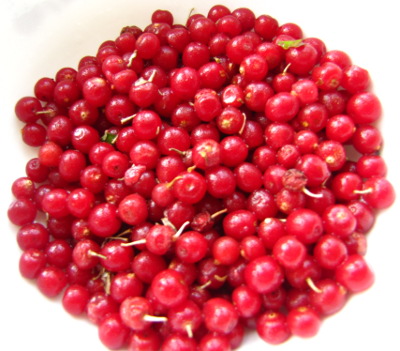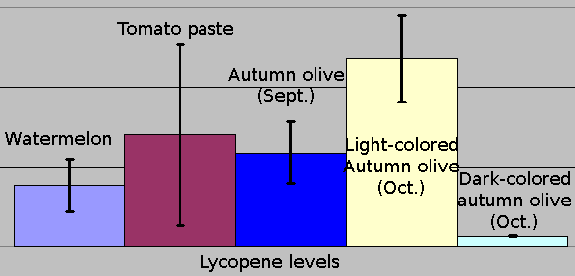
Autumn Olive fruits
 Our movie star neighbor has
been singing the praises of Autumn Olive
fruits for the least few weeks. He discovered that they are very
high in lycopene, so he set out to harvest gallons of the little red
berries, then turned some into fruit leather and froze the rest.
Our movie star neighbor has
been singing the praises of Autumn Olive
fruits for the least few weeks. He discovered that they are very
high in lycopene, so he set out to harvest gallons of the little red
berries, then turned some into fruit leather and froze the rest.
I have to admit that as
soon as someone says "Autumn Olive," I snarl "Invasive!!" and stop
listening to any words of praise. However, when Mark came home
from a visit to our neighbor's farm with a container of berries, I had
to sample.
My first taste of the
berries made me almost wish I believed in planting invasives in my yard
--- delectable! Autumn Olive fruits are both tart and sweet
(comparable to a Winesap apple), with a very unique flavor that reminds
me of the sweet, ornamental crabapples we used to scavenge on our walks
home from the library as a kid. Autumn Olive berries do have
seeds, but the seeds are about the consistency of a cashew, so it's
easy to just chomp the whole thing up.
However, as the first
delight faded, I noticed a bit of an odd aftertaste that made me less
and less inclined to nibble on later handfuls. There was also a
bit of the mouth-puckery feeling you get from accidentally imbibing a
chunk of pecan shell with your nuts, a sure sign of tannins. In
contrast to my usual behavior with fresh fruits, I ended up not feeling
inclined to finish the whole bowl.

Meanwhile, I wanted to
check out Frankie's assertion that Autumn Olive fruits have twice as
much lycopene as tomatoes. I stumbled across this
study which compared
the lycopene content of watermelon, tomato paste, and Autumn Olive
fruits collected at different times. As you can see from the
large spread of values for each category (the black bars) in the chart
above, lycopene concentration is highly variable in all three types of
fruits. It looks like picking light-colored Autumn Olive berries
late in the fall will give you the most lycopene, and that in some
cases lycopene content can be twice as high as (or even higher than)
tomato paste's lycopene content.
If you're looking for
lycopene, please do harvest as many Autumn Olive berries as possible
--- birds spead the seeds far and wide when they eat the fruits, so the
more you eat, the fewer invasives will pop up next year. However,
be very leery of extracting the seeds and putting them in your compost
pile or of feeding the fruits to chickens (who will poop out the seeds
and start an invasive problem in your pasture.) I can't emphasize
strongly enough how I've seen Autumn Olives take over disturbed ground
in my area, outcompeting native plants. Don't plant your way into
becoming part of the problem; eat your way toward a solution!
Want more in-depth information? Browse through our books.
Or explore more posts by date or by subject.
About us: Anna Hess and Mark Hamilton spent over a decade living self-sufficiently in the mountains of Virginia before moving north to start over from scratch in the foothills of Ohio. They've experimented with permaculture, no-till gardening, trailersteading, home-based microbusinesses and much more, writing about their adventures in both blogs and books.
Want to be notified when new comments are posted on this page? Click on the RSS button after you add a comment to subscribe to the comment feed, or simply check the box beside "email replies to me" while writing your comment.

We love your site and the entire concept of a "walden effect". After building up a woodworking business in Brooklyn we moved onto an old, unused farm in upstate NY. It had a barn from 1850 with a dirt floor and holes in the roof and a farm house that was uninsulated, no wood stove, a failing boiler - in fact just about everything was falling apart! LOL we had some serious doubts after we moved in! But we managed year by year to repair and rebuild and now run the business out of the barn. We really needed the space and the ability to have Nature right outside the front door.
I just read your comments on Autumn Olive fruits and want to write back. We first got interested in AO when we noticed the berries growing on our overgrown land. After identifying them and trying them we were hooked and have been cooking with them for years. We came to learn both that they are really nutritious and also like to invade in certain areas. So picking them gets you a healthy fruit and also reduces the invasive spread! This was the germ of an idea which we decided to develop into it's own venture and we now sell AO products which we market as Lycoberry.
We've had the chance to meet and talk to a lot of people about AO and have built up a network of foragers in NY, MI, TN, and IL. This will enable us to harvest over 30,000 lbs. this year. Of course that's barely a drop in the bucket but we're trying to get the word out to all foragers and also make a name for this berry.
One of the things I like about the project is that I think a brand can be built that doesn't really require the typical hype and noise that plagues other "superfruits". That fact is that the berries contain around 17 times as much lycopene as raw tomatoes. Of course there are variations and one of my Michigan foragers found berries which tested at 35 times the lycopene of tomatoes.
The other fact is that there's a lot of research that's been done now and is ongoing which concludes that lycopene plays an important role in disease prevention. We've put up a lot of the most recent studies about this on our website but encourage people to actively educate themselves about lycopene. It's not some vague, marketing term like ORAC value. It's a bioactive compound that occurs naturally and has been produced synthetically and about which a large scientific literature has grown up.
So we're optimistic that AO products can be marketed with a narrow focus and a real benefit. We also hope that there will one day be a market for the berry so that more and more people will want to harvest the fruit. If these conditions arise it could be a win-win-win: public health benefit-economic benefit to harvesters-reduction of an invasive species.
I hope you'll consider posting again about AO and also visit us at www.lycoberries.com to learn more about what we're doing. We welcome collaboration!